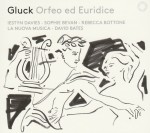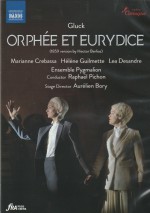Gluck – Orfeo ed Euridice
Iestyn Davies; Sophie Bevan; Rebecca Bottone; La Nuova Musica; David Bates
Pentatone PCT 5186 805
(pentatonemusic.com)
Gluck – Orphée et Euridice
Marianne Crebassa; Hélène Guilmette; Lea Desandre; Ensemble Pygmalion; Raphaël Pichon
Naxos 2.110638 (naxos.com)
 Gluck’s Orfeo ed Euridice is a landmark work in the operatic canon, as famous for its restoration of the ideals of Greek art in opera seria as it is for its musical and dramatic content. As well as being aesthetically progressive through its deliberate conservativism, Orfeo merges French and Italian styles into a synthetic whole, combining the Italianate style utilized by Handel and Vivaldi with the influence of Lully and Rameau. First premiered in Vienna in 1762, Gluck later re-adapted the opera to suit the tastes of a Parisian audience at the Académie Royale de Musique and several alterations were made in vocal casting and orchestration to suit French tastes.
Gluck’s Orfeo ed Euridice is a landmark work in the operatic canon, as famous for its restoration of the ideals of Greek art in opera seria as it is for its musical and dramatic content. As well as being aesthetically progressive through its deliberate conservativism, Orfeo merges French and Italian styles into a synthetic whole, combining the Italianate style utilized by Handel and Vivaldi with the influence of Lully and Rameau. First premiered in Vienna in 1762, Gluck later re-adapted the opera to suit the tastes of a Parisian audience at the Académie Royale de Musique and several alterations were made in vocal casting and orchestration to suit French tastes.
Between 1784 and 1859 the concert pitch in Paris rose so significantly that the French government passed a law which set the A above middle C at 435 Hz. To combat the effects of this inflation in pitch, Hector Berlioz prepared a version of Gluck’s opera (Orphée et Eurydice) in which he adapted the title role for a female alto using the key scheme of the 1762 Vienna score, and incorporating much of the additional music of the 1774 Paris edition. Although Berlioz’s version is one of many which combine the Italian and French scores, it is the most influential and well regarded and has since been revised and reissued in numerous editions.
 It is Berlioz’s 1859 version of Gluck’s opera which the Opéra Comique presents in their DVD Orphée et Eurydice, a wonderful representation of Gluck’s artistry and reflection of Berlioz’s craft as adapter. The style and performance practice are decidedly classical, rooted in the 18th-century tradition, and Berlioz’s personal influence is appropriately indiscernible. There are, however, some notable modifications to Gluck’s original score: the overture has been replaced with another of Gluck’s orchestral overtures; and the harpsichord is nowhere to be found, a decision that is open to interpreters, as the instrument was removed from the Parisian orchestral pit around the time of Orphée’s premiere. This is an overall weightier approach to Gluck, with a larger orchestra playing with full sound and prominently voiced soloists, suggesting a 19th-century approach commensurate with the sound Berlioz likely had in mind.
It is Berlioz’s 1859 version of Gluck’s opera which the Opéra Comique presents in their DVD Orphée et Eurydice, a wonderful representation of Gluck’s artistry and reflection of Berlioz’s craft as adapter. The style and performance practice are decidedly classical, rooted in the 18th-century tradition, and Berlioz’s personal influence is appropriately indiscernible. There are, however, some notable modifications to Gluck’s original score: the overture has been replaced with another of Gluck’s orchestral overtures; and the harpsichord is nowhere to be found, a decision that is open to interpreters, as the instrument was removed from the Parisian orchestral pit around the time of Orphée’s premiere. This is an overall weightier approach to Gluck, with a larger orchestra playing with full sound and prominently voiced soloists, suggesting a 19th-century approach commensurate with the sound Berlioz likely had in mind.
In contrast with the Opéra Comique’s presentation, Pentatone has issued a new recording of the 1762 Orfeo which includes both harpsichord and the original overture, as well as a countertenor Orfeo. This version is, although very similar to the Berlioz edition, considerably leaner in its orchestral timbre and more fluid with its Italian text, further emphasized through an interpretation that is deliberately direct and essentially Baroque, rather than bold and Romantic. In both instances the singers, choruses and orchestras are magnificent, presenting Gluck’s music in equally superb and successful ways.



